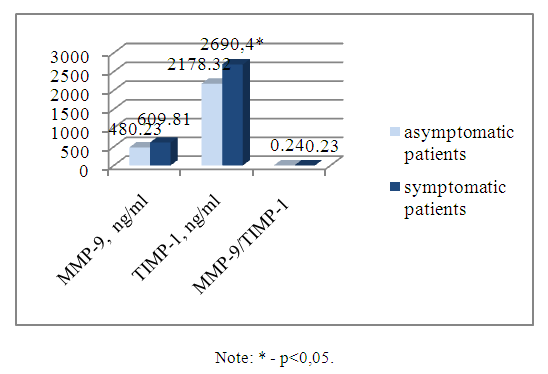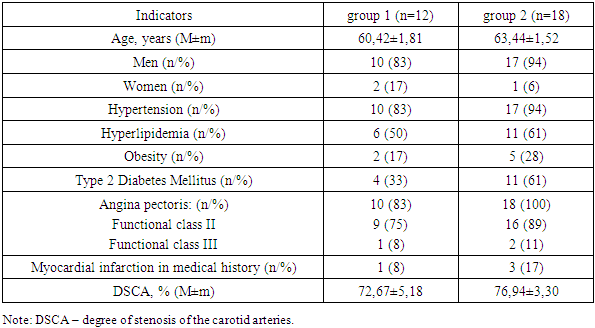-
Paper Information
- Previous Paper
- Paper Submission
-
Journal Information
- About This Journal
- Editorial Board
- Current Issue
- Archive
- Author Guidelines
- Contact Us
American Journal of Medicine and Medical Sciences
p-ISSN: 2165-901X e-ISSN: 2165-9036
2025; 15(3): 678-681
doi:10.5923/j.ajmms.20251503.41
Received: Feb. 22, 2025; Accepted: Mar. 10, 2025; Published: Mar. 13, 2025

Zinc Levels in Serum, Hair, and Atherosclerotic Plaques, and MMP-9/TIMP-1 Concentrations in Carotid Atherosclerosis: Insights from Symptomatic and Asymptomatic Patients
Usmanova Z. A.1, Rozikhodjaeva G. A.2
1Center for the Development of Professional Qualifications of Medical Workers, Tashkent, Uzbekistan
2Clinical Hospital №1 of the Head Medical Department under the Administration of the of the President of the Republic of Uzbekistan, Tashkent, Uzbekistan
Correspondence to: Usmanova Z. A., Center for the Development of Professional Qualifications of Medical Workers, Tashkent, Uzbekistan.
| Email: |  |
Copyright © 2025 The Author(s). Published by Scientific & Academic Publishing.
This work is licensed under the Creative Commons Attribution International License (CC BY).
http://creativecommons.org/licenses/by/4.0/

This study explored zinc levels in serum, hair, and carotid artery atherosclerotic plaques, along with the concentrations of matrix metalloproteinase-9 (MMP-9) and tissue inhibitor of metalloproteinase-1 (TIMP-1) in serum, in patients with carotid atherosclerosis, comparing asymptomatic individuals with those who had experienced a stroke. In stroke patients, serum TIMP-1 levels were significantly higher than in asymptomatic patients. Furthermore, patients with symptomatic carotid atherosclerosis exhibited lower serum zinc levels and zinc concentrations in atherosclerotic plaques compared to asymptomatic patients, emphasizing the role of zinc in the pathogenesis of carotid atherosclerosis complications. Elevated blood glucose levels were associated with reduced zinc levels in hair, while higher MMP-9 concentrations in serum were correlated with increased zinc levels in serum and a decrease in zinc concentrations in hair.
Keywords: Matrix metalloproteinase-9 (MMP-9), Tissue inhibitor of metalloproteinase-1 (TIMP-1), Zinc of the serum, Hair, Atherosclerotic plaques of carotid artery, Carotid atherosclerosis, Stroke
Cite this paper: Usmanova Z. A., Rozikhodjaeva G. A., Zinc Levels in Serum, Hair, and Atherosclerotic Plaques, and MMP-9/TIMP-1 Concentrations in Carotid Atherosclerosis: Insights from Symptomatic and Asymptomatic Patients, American Journal of Medicine and Medical Sciences, Vol. 15 No. 3, 2025, pp. 678-681. doi: 10.5923/j.ajmms.20251503.41.
Article Outline
1. Introduction
- Coronary artery disease and cerebrovascular disorders are major factors contributing to mortality in several countries. These diseases significantly contribute to the overall mortality rate, accounting for 82.3% in men and 85.8% in women [1]. Atherosclerosis plays a key role in the development of these diseases. Approximately 75% of coronary thrombosis cases leading to myocardial infarction and about 90% of carotid thrombosis cases causing acute cerebrovascular accidents are caused by the instability of atherosclerotic plaques (AP) [2]. Currently, there is no widely accepted method for predicting a stroke before the onset of the first symptoms. In patients with symptomatic carotid artery stenosis, activation of matrix metalloproteinases (MMPs), tissue inhibitor of metalloproteinases (TIMP), and S100B protein may be observed [11]. Zinc (Zn), as an essential trace element for the human body, can significantly influence the development of atherosclerosis. It is involved in various processes related to the risks of atherosclerosis, such as lipid metabolism, glucose metabolism, and blood pressure regulation, performing both positive and negative functions [9]. Numerous studies have shown that zinc deficiency may be associated with risk factors for diabetes and cardiovascular diseases, and that zinc supplementation can have a significant impact on the prevention and treatment of these conditions. Therefore, studying the role of zinc may contribute to the development of new approaches for the prevention and therapy of diabetes and cardiovascular diseases [10]. There is currently sufficient evidence supporting the relationship between zinc levels and atherogenic risk factors; however, the direct interaction between zinc and atherosclerosis remains poorly understood.The aim of the study is to investigate the zinc levels in serum, hair, and atherosclerotic plaques of the carotid artery, as well as the concentrations of MMP-9 and TIMP-1 in patients with carotid atherosclerosis, comparing asymptomatic individuals with those who have suffered a stroke.
2. Materials and Methods
- The study included 148 patients (112 men and 36 women) aged 45 to 89 years (mean age 65.35±0.73 years) diagnosed with carotid atherosclerosis, confirmed by color duplex scanning of the extracranial branches of the brachiocephalic arteries. Patients with hemodynamically significant carotid artery stenosis (n=30) were referred for carotid endarterectomy at the Tashkent Medical Academy. These patients were divided into two groups: symptomatic (n=18) and asymptomatic (n=12), based on the presence or absence of a history of acute cerebrovascular accident (CVA) or transient ischemic attack (TIA).Atherosclerotic plaque samples were obtained immediately after surgery and sent to the laboratory for zinc content analysis. Blood was collected from the antecubital vein the day before surgery in the morning after a 12-hour fast. All venous blood samples were immediately centrifuged, and serum was frozen at -20°C. Serum zinc levels were determined using the “Zinc-Vital” reagent kit (Russia) on a Mindray BS-200 biochemical automatic analyzer (China). Zinc levels in hair and atherosclerotic plaques were measured using inductively coupled plasma optical emission spectrometry on an Optima 2100 DV analyzer (USA). MMP-9 and TIMP-1 concentrations were determined using standard ELISA test kits from Bender-Medsystems GmbH (Austria) on a Plate Reader spectrophotometer from Hospitex Diagnostics (Italy).Statistical analysis included calculating the mean (M) and standard error (m) for each sample, with results presented as M±m. To identify differences between groups, the Student's t-test was applied at a significance level of p<0.05. The correlation between variables was analyzed using Pearson's correlation coefficient.
3. Results and Discussion
- When comparing the symptomatic and asymptomatic patient groups, no significant differences were found in age, gender, lipid levels, or the presence of a history of hypertension, ischemic heart disease, myocardial infarction, and type 2 diabetes. However, in symptomatic patients, the glucose level was 1.3 times higher (7.18±0.68 mmol/L) compared to asymptomatic patients (5.70±0.28 mmol/L) (p=0.05). The clinical and anamnestical characteristics of the patients are presented in Table 1.
|
|
 | Figure 1. Concentrations of MMP-9, TIMP-1, and the MMP-9/TIMP-1 ratio in serum in groups of patients with symptomatic and asymptomatic carotid atherosclerosis |
4. Conclusions
- 1. In patients with carotid atherosclerosis and a history of acute cerebrovascular accident (CVA) or transient ischemic attack (TIA), serum zinc levels and zinc levels in atherosclerotic plaques are lower compared to asymptomatic patients. This confirms the significant role of zinc levels in biological samples in the pathogenesis of carotid atherosclerosis complications.2. Increased blood glucose concentration is accompanied by a decrease in zinc levels in hair.3. As the MMP-9 level in the blood increases, the zinc concentration in serum increases, while it decreases in hair.4. In patients who have suffered a stroke or TIA, the TIMP-1 concentration in serum is higher compared to asymptomatic patients.
Conflict of Interests
- The authors declare absence of conflict of interests.
ACKNOWLEDGEMENTS
- The study had no sponsor support.
 Abstract
Abstract Reference
Reference Full-Text PDF
Full-Text PDF Full-text HTML
Full-text HTML
